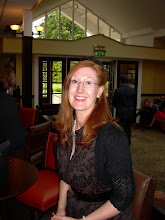 Hockney On Turner, Tate Britain, 11 June 2007 – 3 February 2008
Hockney On Turner, Tate Britain, 11 June 2007 – 3 February 2008I’m happy to admit that I don’t know as much as I should about Turner (or Hockney, for that matter, though I love his trees - see Bigger Trees Near Water, right). Turner’s affinity for wild landscapes seems to be the focus of this exhibition, displayed through sketches and watercolours to the more finished-looking oils for which he is most famous. What had not really occurred to me before, though, is that Turner paints the landscapes of which the Gothic writers write. I am at the moment programmed to find the Gothic in everything, and the Gothic landscape is at the forefront of my mind – critics see it as the representation of the inner eye, a depiction of the mind, as well as indicative of the heights the hero/ine needs to scale to succeed. Yet it is these heights which help the protagonist to achieve the sublime, that state where they are stronger than their opponents and see the world’s frailty for what it is. When Turner paints St Gotthard, for example, and Snowdon Valley, the craggy splendour both terrifies and uplifts (if you are in a Gothic frame of mind like me) and his Gothic eye seems to me to be painting the indistinct period of overlap between the Romantics and the Victorians. Consider the towering, bleak landscape of St Gotthard (below), and compare it to this extract from The Mysteries of Udolpho:
 "At length, the travellers began to ascend among the Apennines. The immense pine-forests, which, at that period, overhung these mountains, and between which the road wound, excluded all view but of the cliffs aspiring above, except, that, now and then, an opening through the dark woods allowed the eye a momentary glimpse of the country below. The gloom of these shades, their solitary silence, except when the breeze swept over their summits, the tremendous precipices of the mountains, that came partially to the eye, each assisted to raise the solemnity of Emily's feelings into awe; she saw only images of gloomy grandeur, or of dreadful sublimity, around her; other images, equally gloomy and equally terrible, gleamed on her imagination."
"At length, the travellers began to ascend among the Apennines. The immense pine-forests, which, at that period, overhung these mountains, and between which the road wound, excluded all view but of the cliffs aspiring above, except, that, now and then, an opening through the dark woods allowed the eye a momentary glimpse of the country below. The gloom of these shades, their solitary silence, except when the breeze swept over their summits, the tremendous precipices of the mountains, that came partially to the eye, each assisted to raise the solemnity of Emily's feelings into awe; she saw only images of gloomy grandeur, or of dreadful sublimity, around her; other images, equally gloomy and equally terrible, gleamed on her imagination."Of course, for the Gothic writers the landscape can depict the awe we feel at the creation of the world, and combine it with the terror of the unknown which lies within it. The natural landscape, with no sign of human occupation, spoke to the readers of Gothic romances as the work of God; and yet Gothic horror is very much the work of mankind, with the bad things that happen being rarely actually supernatural but machinations of the scheming world. Those paintings here which cover manmade scenes (Interior of a Prison, left, for example) still display a towering strength
 in which a carefully-constructed edifice encloses the space and traps the viewer (particularly when the interior is empty of human figures – it is designed to enclose or confine something other than empty space, so if there’s no-one there then it is you that it encloses). This is of course particularly reinforced when the structure is a prison.
in which a carefully-constructed edifice encloses the space and traps the viewer (particularly when the interior is empty of human figures – it is designed to enclose or confine something other than empty space, so if there’s no-one there then it is you that it encloses). This is of course particularly reinforced when the structure is a prison.Even in the freshness of his mid-period, his watercolour washes with their pastel colours and intense immediacy, with the brush-strokes apparent, there is a lurking threat of gathering storm clouds: this seems to be the pastoral image of the start of a Gothic novel, where all seems tranquil but the reader knows that something must threaten the happiness of the as yet undeveloped characters. Gothic has strong overtones of temptation and fall, and as such Milton is considered to be a great influence on writers of Gothic, so perhaps the apotheosis of the Gothic that I saw here is in The Temptation on the Pinnacle, which illustrates Milton, though the illustrations for Scott’s Poetical Works come close, depicting the untamed Scottish scenery of which Scott was a masterful illustrator in words.










